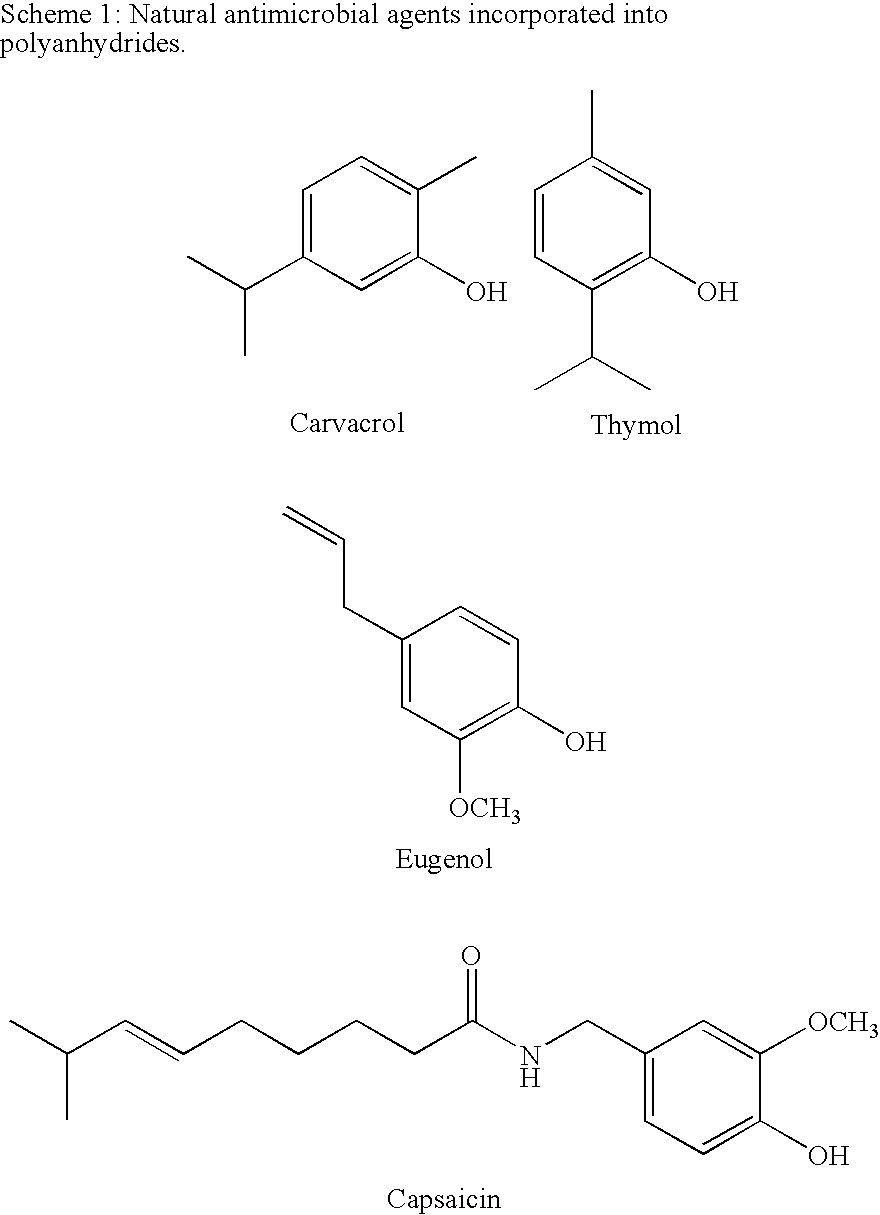Biodegradable polyanhydrides with natural bioactive molecules
a bioactive and biodegradable technology, applied in the field of biodegradable polyanhydrides with natural bioactive molecules, can solve the problems of biofilms and bacterial growth, which are currently a major problem
- Summary
- Abstract
- Description
- Claims
- Application Information
AI Technical Summary
Benefits of technology
Problems solved by technology
Method used
Image
Examples
example 1
Preparation of Representative Polymers of the Invention
[0052]Polyanhydrides prepared from antimicrobials derived from natural sources such as spices and plant extracts were designed and synthesized (Schemes 1 and 2) (Cowan, M. M. Clinical Microbiology Reviews 1999 12, 564-582) One application of these polymers is their formulation into micro- or nanospheres, which can then be mixed with foods. The polymers could also be used to coat food processing equipment. Alternatively, other bioactive agents can be physically admixed into the antimicrobial-based polyanhydrides to result in a dual action delivery device.
EXPERIMENTAL
[0053]Instrumentation. Polymers and intermediates were characterized by proton nuclear magnetic resonance (1H NMR) and Fourier transform infrared spectroscopy (FTIR). Polymer properties were determined using gel permeation chromatography (GPC) for molecular weights and polydispersity, thermogravimetric analysis (TGA) for decomposition temperatures (Td), and differenti...
example 2
Preparation of Representative Polymers of the Invention
[0061]Polyanhydrides were designed and prepared from antimicrobials derived from natural sources such as spices and plant extracts. Incorporation of these bioactive molecules into the polymers results in biodegradable polyanhydrides that slowly release the bioactive agents to reduce or prevent biofilm formation, e.g., when incorporated into food and food packaging materials.
Plant-based Polymers: Choice of Bioactive Molecules
[0062]Plant and plant extract-based polymers were designed using the natural antimicrobials carvacrol, eugenol, and thymol. Polymers were derived from these bioactive molecules to prevent biofilm formation, e.g., when formulated into food products, food packaging materials and food processing equipment.
Ethylenediaminetetraacetic Acid (EDTA) Polymers
[0063]The biocompatible food-grade chelating EDTA was used as a polymer precursor. EDTA is widely used as preservative in packaged foods, vitamins, and personal ca...
example 3
Hydrolytic Degradation of Representative Polymers
[0068]Hydrolytic degradation of representative polymers can be studied to determine the rate of release of the natural antimicrobial from the polymer backbone. Polymers will be incubated in PBS (pH 7.4) at 37° C. At predetermined time intervals, the media will be replaced with fresh media, and the spent media will be analyzed by HPLC. See for example: Whitaker-Brothers, K.; Uhrich, K. E. J. Biomed. Mater. Res. 2006, 76A, 470-479; Prudencio, A.; Schmeltzer, R. C.; Uhrich, K. E. Biomacromolecules 2005, 38, 6895-6901; and Bryers, J. D.; Jarvis, R. A.; Lebo, J.; Prudencio, A.; Kyriakides, T. R.; Uhrich, K. Biomaterials 2006, 27, 5039-5048.
PUM
| Property | Measurement | Unit |
|---|---|---|
| pH | aaaaa | aaaaa |
| area | aaaaa | aaaaa |
| bioactive | aaaaa | aaaaa |
Abstract
Description
Claims
Application Information
 Login to View More
Login to View More - R&D
- Intellectual Property
- Life Sciences
- Materials
- Tech Scout
- Unparalleled Data Quality
- Higher Quality Content
- 60% Fewer Hallucinations
Browse by: Latest US Patents, China's latest patents, Technical Efficacy Thesaurus, Application Domain, Technology Topic, Popular Technical Reports.
© 2025 PatSnap. All rights reserved.Legal|Privacy policy|Modern Slavery Act Transparency Statement|Sitemap|About US| Contact US: help@patsnap.com



